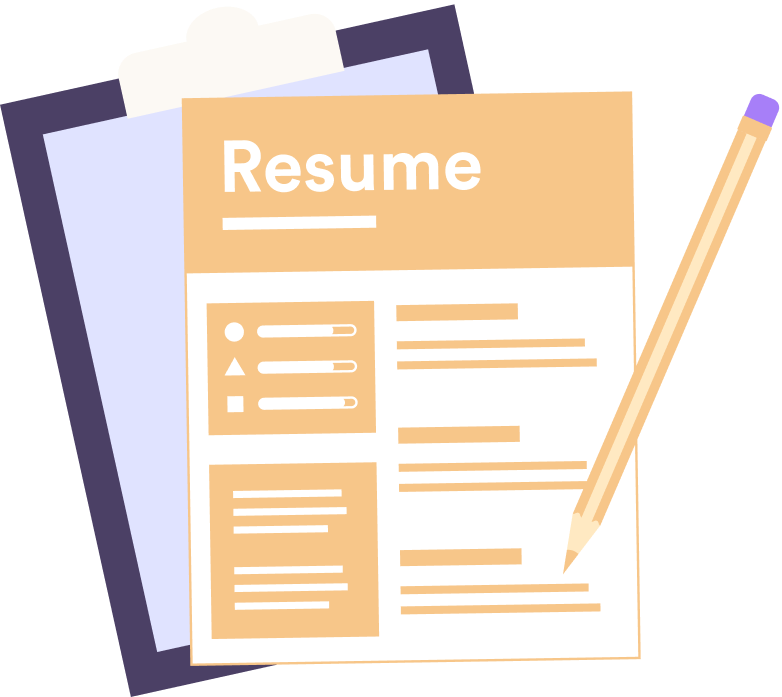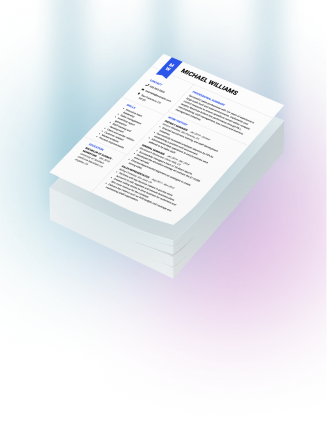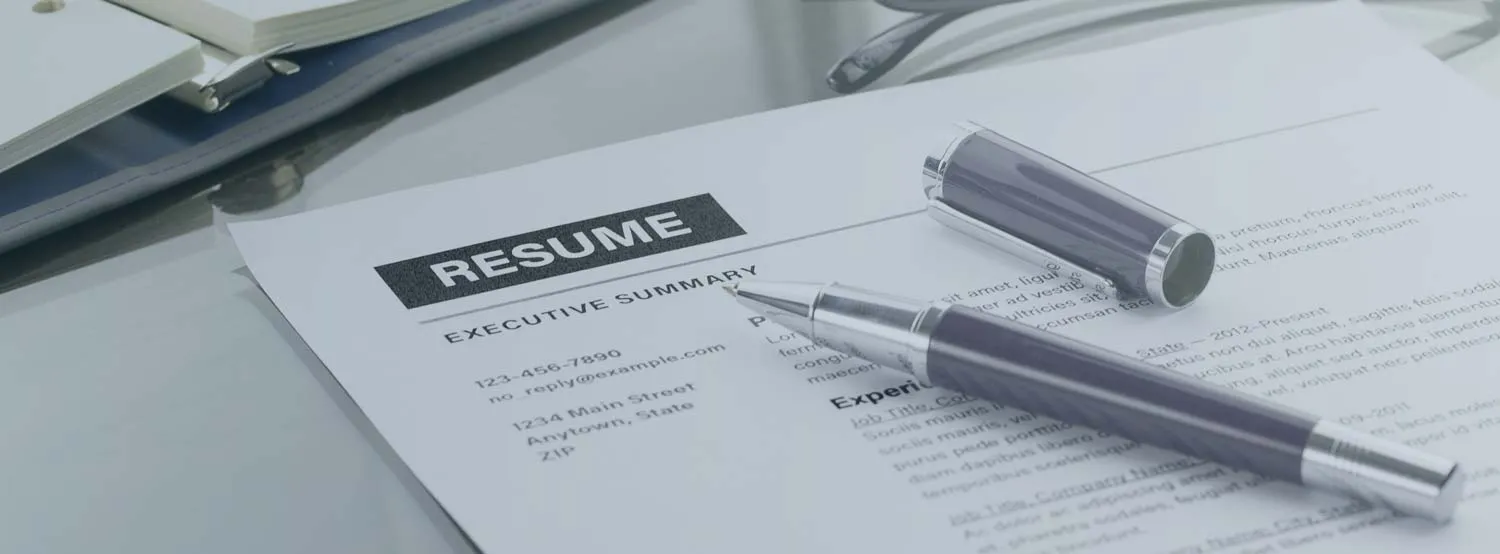Our customers have been hired by*:*Foot Note

Resume Writing Strategies
In order to get the job you want, you need to focus on the very best qualities you possess in your resume, and present a compelling narrative that will interest hiring managers. Employing the right resume writing strategies and incorporating them into your documents will help you bypass some of the common pitfalls candidates face, and help you create a professional presentation of your qualifications.
Check out our expert strategies below that will get your resume noticed:
- Identifying your transferable skills
- Highlighting the right accomplishments
- Figuring out how to use resume templates and examples to your advantage
Resume writing techniques and strategy
There are many different programs and techniques out there that claim to make you an employer magnet or make your resume “unrejectable” but predicting what will work for the job you want changes as fast as employers (and the ATS programs they use to scan resumes) can update their requirements. The only truly effective resume strategy is knowing what a resume is and how to best show off your qualifications with one.
The purpose of a resume is to introduce yourself to an employer and prove you’re the best fit for the role by explaining your most relevant skills and experiences. To do this effectively your document needs to show these essential qualities:
- Creativity: Are you good at finding new solutions to problems? Can you make a product or service easier to use or understand?
- Communication: Do you relate to people or customers easily? Are you an effective team leader?
- Collaboration: Do you value open-mindedness? Are you a great listener?
- Critical Thinking: Can you visualize a big-picture perspective? Do you value problem solving and using resources wisely?
This all boils down to being able to talk about how you created results, got something done on time, contributed to your organization and the steps you took to get there. The advice below can tell you how and where to place this key information in your resume.
5 resume writing strategies and tips
1. Know your audience
Most resumes are written to entice and interest an employer so the most effective thing you can do is to stop thinking about yourself as the main point of the resume. Instead, you should build your document around what your reader is looking for and expecting to see. The description of the job will tell you what the recruiter is looking for; to begin the writing process note specific skills and experiences that the job requires. Then, in your resume, plan to describe yourself in the same way the job description talks about the ideal applicant. For example, if the description says they’re looking for a “Self-motivated and detail-oriented customer service representative with three years of experience,” highlight any skills and past achievements that show you match what the role requires (e.g., three years of experience, organized, customer-focused).
2. Content should be short and to the point
There should be no wasted words in a resume. Keep your sentences concise, and present your information in a direct and effective manner. Make sure that each and every piece of information you are using is relevant to the job you’re applying for. If tasks that you performed for one particular employer are not going to enhance your resume, then leave them out and keep your resume strong. Read each statement carefully and remove any words or phrases that don’t add to your message. Keep your resume as a single-page document unless you’re applying for a senior role and have plenty of experience to back up your qualifications. Two-page resumes are less common and run the risk of losing a hiring manager’s attention, especially if you don’t include information that targets what the job wants.
3. Format with applicant tracking systems in mind
You should never submit exactly the same resume to more than one job application. It’s important to personalize your resume so it fits each job you apply to. Ensure your resume template follows applicant tracking system (ATS) standards. Choose a professional font like Arial, Helvetica and Times New Roman. Mention the exact skills and keywords that are in the job posting and include professional experience that directly relates to the responsibilities of the new job. This way, you’ll be able to capture all the requirements and indicators for each job application. When you keep an ATS favorable resume strategy in mind you’re presenting yourself exactly the way the company wants to see an applicant.
4. Lead with your best information
With each entry on your resume, you have to lead with the best information you have. While a compelling narrative is necessary, a resume is not a short story that relies on a surprise ending to be effective. Instead of just throwing every skill you have and listing every responsibility from past jobs, focus on the important ones. Mention work accomplishments that show off how good you are and make sure to include a number or quantifiable metrics, (e.g., “Handled 20+ customers per day by effectively identifying needs, quickly gaining trust, approaching complex situations and resolving problems.”).
5. Use a resume format that’s easy to read
It’s important to make sure that your resume can be viewed by both systems and hiring managers so keep the look of your resume uniform by properly using white space and using the same font throughout your resume. Being consistent with the elements you use to present your information is important for both visual appeal and readability. For example, if you bold the job title on one of your job history entries, then make sure that you bold all of your job titles to keep the look of your resume consistent. It’s also important to proofread all documents as your resume might have the right “look” and impressive credentials, but all of your hard work might go to waste if the recruiter finds a typo. Reread your resume a few times before sending it in, checking for accuracy, grammar and spelling. You can save time with our Resume Builder, which has customizable resume templates and features a handy spell-checking tool that scans your resume.
Build my resumeHow to write your resume, from top to bottom
Now that we’ve given you the best strategies for optimizing your resume, it’s time to put together each section of your document. For insights on how to write each section of your resume, follow these tips:
How to make a resume – We’ll walk you through the complete resume writing process, from start to finish.
Resume header – The header contains your contact information, including your phone number, your location (city and state of residence) and a professional email address where you can be reached. You can also include a link to a professional portfolio or profile site, such as your page on LinkedIn, or a social media account (if you use it for work).
Resume summary – Lead off your resume with a strong statement about how you are as a job candidate, featuring your top experiences and skills, all within a few sentences.
Resume objective – If you don’t have much professional experience, you may want to write an objective instead of a summary. An objective focuses on your best skills and your career goals.
Skills section – In bullet-point lists, present your top qualifications and abilities. Don’t forget to provide a mix of hard skills and soft skills.
Work experience section – List your previous (and current) jobs, with three to five bullet points under each job listing describing your top accomplishments. Be specific about your achievements, and try using numbers to quantify your successes (e.g., “Headed revamp of inventory processes that resulted in 15% increased productivity.”).
Education section – Keep this section concise, listing your highest academic achievements (e.g., bachelor’s or postgraduate degree), and include any notable certifications or honors you’ve earned.
More resume and job search resources
We have dozens of expert articles with more resume tips and career advice to help you put your best foot forward.
- Choosing the right template: An important part of your resume strategy is figuring out how your document should look, let us help with tips from the top career industries.
- Resume design: Get more resume tips on how to design a professional resume.
- How to make a resume with no experience: Making a resume with no prior work experience might seem daunting but follow our advice and you’ll have a great resume done in no time!
- Should you list references on a resume?: Find the answer to that question and how to approach others to make them a professional reference.
- General interview tips: Prep for an interview with our expert tips and professional advice.
- Phone interview questions: Practice our phone interview questions and impress recruiters right off the bat.
- Questions to ask an interviewer: Show potential employers your interest in the job opening by asking them important questions during the job interview.
FAQ: Resume Writing Strategies
Have questions? We’re here to help.
Does resume strategy matter?
Yes. There are a lot of systems and biases in place that make it difficult to have your work and experience recognized by the right people. An effective resume strategy is important because it helps put a path in place for you to modify your documents and portfolio in a way that helps get your foot in the door.
To ensure your professional resume hits the right key points, use the friendly step-by-step guidance our Resume Builder provides.
What are the key points for resume writing?
A good resume emphasizes a combination of work history, skills and education in order to show a hiring manager that you are the right fit for the job you are applying for. Meaning that when it comes to crafting your resume you should:
- Keep your resume short and direct. It’s important to only put the best and most relevant information in your document.
- Highlight relevant skills and experiences. Don’t just list the skills and abilities you possess, show how those specific qualities that only you possess achieved positive results.
- Craft a great career snapshot. Only show the highlights that best reflect your work, no negative talk about bosses, coworkers or yourself.
- Show optimized creativity. Use a pop of color or a unique (but readable) template that fits with the role you’re applying to.
What are some resume tips for students?
Students and those writing their first resumes should still begin with a skills-first approach, they just have to think beyond general job duties and focus their resume on transferable skills that would best show their qualifications. It’s also advised to discuss the reason for your interest and connection to the industry or company briefly in your summary or objective statement (and more in-depth in your cover letter) to give the hiring manager an idea of what drew you to the role in the first place.
How to improve my resume writing skills?
The best way to improve any skill is to find the time to practice it. When it comes to resume writing, the thing you want to practice most is turning your focus from the common responsibilities of your role to the things you achieved. A bad resume lacks both measurable and individualized outcomes. Instead of listing the tasks you perform or talking about your company’s accomplishments, explain how you used your skills to create measurable results and the significance of what you accomplished. Knowing the significant contributions you’ve made to the company and how to write about them can help improve every section of your resume but especially the work experience section, which will help hiring managers recognize your qualifications faster. For further reference, check out our resume examples for specific jobs, which can help you shape your own resume.
Couldn't find the answer you're looking for?







